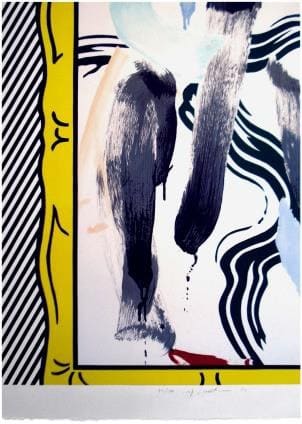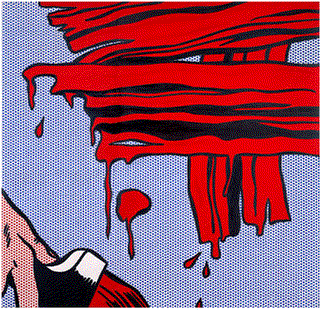Roy Lichtenstein was born and raised in Manhattan’s Upper West Side. His family was able to provide him with a good education and exposed him to the museums and theaters around New York. He went on to become a thoughtful artist and educator, whose work influenced the direction of art in America and around the world.
Brushstrokes in Chinese Painting and Lichtenstein’s Art
Lichtenstein was drafted in 1944 and sent to London, where he was able to visit museums and see the works of European painters. While in London, he bought a book about Chinese painting, which had a significant influence on his later work. Chinese painting has a history dating back to 475 BC. Based on the brushstroke and calligraphy, Chinese painting has guidelines, that were written by Chinese art historian Xie He, in the 6th century.
The Six Principles that Xie He outlined, when considering the merits of a painting, are:
- Spirit Resonance: the energy or spirit of the work
- Bone Method: the quality and texture of the brushstroke
- Correspondence to the Object: how well defined the shape and lines of what is depicted
- Suitability to Type: how well the artist has used color and shades
- Division and Planning: the composition on the canvas
- Transmission by Copying: the quality of the artist’s rendering of a subject
When looking at Brushstrokes on Canvas, the qualities that Xie He outlined are evident. Lichtenstein set guidelines for himself and carefully constructed each painting with an almost mathematical precision. His use of Ben Day dots, one of the features that defined his work, had to be meticulously applied, as did the patterns he used as background, patterns he used to frame his subjects and patterns to create the subjects themselves. Ironically, Lichtenstein’s first group exhibition was held the summer of 1949, in New York, at Chinese Gallery, which displayed both American art and classical Chinese art.
Roy Lichtenstein’s Brushstroke Series
In 1965, Lichtenstein began working on the Brushstroke Series. His inspiration was a comic book cell, done by Dick Giordano. Giordano’s work depicted an artist who emotionally drained after completing a painting. Lichtenstien’s first Brushstroke painting was very similar to the work of Giordano but Lichtenstien continued to use the brushstroke in varying ways for the rest of his career.
In an interview in the 1990s, Lichtenstein explained why the brushstroke figured so prominently in his work, “It (the Brushstroke) was the way of portraying this romantic and bravura symbol in its opposite style, classicism. The Brushstroke plays a big part in the history of art. Brushstroke almost means painting or art. I did isolated Brushstrokes in 1965 and used cartoon brushstrokes to depict subject matters in the 1980s. I also did Brushstroke sculptures in bronze and wood to make them more palpable. … the Brushstroke, it is just an idea to start with, and painting it makes it more concrete, but when you do it in bronze sculpture, it becomes real and has weight and is absurd, contradictory and funny.” His Brushstroke sculptures can be seen at the Smithsonian in Washington, D.C. and in cities around the world, including Paris and Tokyo.
Roy Lichtenstein Brushstroke on Canvas at Surovek Gallery
Please contact us for more information about Brushstroke on Canvas or any of the other works by Roy Lichtenstein and other fine artists available at Surovek Gallery.
References:
Sickman, Laurence The Art and Architecture of China. Pelican History of Art, 3rd ed 1971, Penguin
Mercurio, Gianni (2010). Roy Lichtenstein: Meditations on Art.



